Scientific Classification
Species in the Genus
Species in Kenya, Tanzania & Uganda
Description
Possible Causes of Confusion
Distribution in Kenya, Tanzania & Uganda
Habitats
Nesting
Crops Visited
Other Plants Visited
Economic / Ecological Importance
Threats
Conservation and Management Practices
Legislation (National and International)
References
Editors
Acknowledgements
Contact
Click on images to enlarge
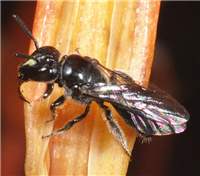
Braunsapis species. © Bernhard Jacobi
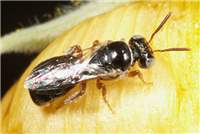
Braunsapis species. © Bernhard Jacobi
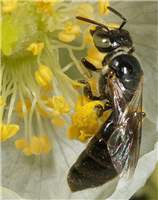
Braunsapis species. © Bernhard Jacobi
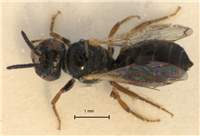
Braunsapis bouyssouri (female) - pinned specimen. Photo: Connal Eardley
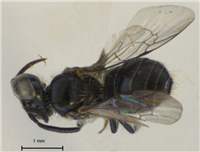
Braunsapis bouyssouri (male) - pinned specimen. Photo: Connal Eardley
Summary
Honey bees are not the only bee species that are significant for human wellbeing. Braunsapis bees are a group of native bee species that do not produce honey but are likely to be important pollinators of crops and wild plants. Females have a sting, but they are not aggressive and will only sting if handled. These small, lean and mostly black-coloured species live independently of others (i.e. they are solitary) and nest in stems and twigs. This fact sheet provides information about these bees to encourage farmers to understand and protect them to help ensure that their crops are effectively pollinated.
From a conservation and agricultural standpoint it is not necessary to recognise all the different bee genera. However, it is important to know that there is a large bee biodiversity. Different bee genera pollinate different plant species, although there is some overlap that acts as a buffer as bee populations wax and wane. For healthy ecosystems, including agro-ecosystems both diversity and abundance in the bee fauna is important.
Common Name (Language)
Reed bees (English), bees of the tribe Allodapini share this common name with bees in the genus Ceratina
Scientific Classification
Kingdom: Animalia
Phylum: Arthropoda
Class: Insecta
Order: Hymenoptera
Family: Apidae
Subfamily: Xylocopinae
Tribe: Allodapini
Genus: Braunsapis Michener, 1969
Species in the Genus
Currently there are about 89 species of Braunsapis recorded in different parts of the world, particularly in Africa, Asia and
Species in Kenya, Tanzania & Uganda
Twenty species of Braunsapis bees have been recorded from Kenya, Tanzania and Uganda (Eardley and Urban 2010) but more detailed survey work is needed to provide more accurate information on the number of species in these countries and their distributions.
Description
Braunsapis bees are not well known by local people (including farmers) in
Possible Causes of Confusion
Braunsapis bees could be confused with Macrogalea bees. It is possible to distinguish these bees since Macrogalea bees are hairier and slightly larger. These bees can be confused with small insects such as wasps but it should be possible to differentiate these wasps have a constriction (“waist�?) at the junction of their abdomen and thorax which is absent in bees.
Distribution in Kenya, Tanzania & Uganda
In Kenya, these bees have been recorded in Kakamega. However, considering their habitats and nesting requirements in other parts of Africa, it is possible that these bees are well distributed in
Habitats
Considering their nesting requirements, these bees can be found in different habitats such as arid and semi-arid lands, lowlands, forests and even open farmlands where plants such as Lantana do well.
Nesting
These solitary bees prefer to nest in plants that have pithy stems such as Kilimanjaro basil (Ocimum kilimandscharicum) and lantana (Lantana camara). In addition, they are reported to nest in Acacia thorns, twigs of raspberries and black berries. Their nests have also been reported on dead canes.
Crops Visited
There is little information about the pollination ecology of these bees. However, they have been reported to visit plants in the family Compositae (Asteraceae), which is one of the largest families among the flowering plants. Some of the crops include sunflower and, chrysanthemums. Other crops visited include raspberries and black berries among others. There is need to confirm their economic importance for pollination of crops and plants of interest to humanity.
Other Plants Visited
Plants in the family Compositae are visited such as marigolds. Also they are known to visit flowers of lantana and Kilimanjaro basil.
Economic / Ecological Importance
Little information exists on the usefulness of these bees to the lives of the people in
Threats
In
Conservation and Management Practices
There are now concerted research efforts in the region to develop best practices for conservation and management of bees that are compatible with other good farm practices, to enhance crop production. Theoretically, bee conservation and management is inexpensive and adopted activities can also improve the aesthetic value of the landscape. Such practices involve setting land aside (e.g. a 1-metre strip) in the farmland to host all year round food resources for the bees, as well as safer sites for nesting, mating, resting and refuge from natural enemies. During flowering, farmers should manage pesticide usage carefully to avoid poisoning flower-visiting bees. Farmers should also minimise pesticide drift from the field to adjacent areas. Laws governing registration and use of plant protection products indirectly play a major role in the protection of pollinators. KARI (the Kenya Agricultural Research Institute) is developing protocols for mass rearing of different species of solitary bees. Any successful results from this research will be freely communicated to the public. In addition, KARI is collaborating with other stakeholders to ensure in situ conservation and management of bees for pollination purposes. Much of the work of conserving native bees will be underpinned by raising public awareness of the importance of these species.
Legislation (National and International)
There is not yet any legislation in
References
1. Eardley CD and Urban R (2010) Catalogue of Afrotropical bees (Hymenoptera: Apoidea: Apiformes). Zootaxa, 2455: 1–548.
2. Michener CD (1974) The Social Behavior of the Bees, Harvard University Press, pp. 307–309
3. Michener, C.D. (1975a) A taxonomic study of African allodapine bees (Hymenoptera, Anthophoridae, Ceratinini). Bulletin of the American Museum of Natural History, 155, 67–240.
4. Michener, C.D. (1975b) Larvae of African allodapine bees. 2. Braunsapis and Nasutapis (Hymenoptera: Xylocopinae). Journal of the Entomological Society of Southern Africa, 38, 223–242.
5. Michener CD (2007) The Bees of the world, the John Hopkins University Press, Baltimore and London, pp 913.
Editors
Théodore Munyuli, Busitema University - Uganda; Muo Kasina, Kenya Agricultural Research Institute (KARI) - Kenya; Juma Lossini, Tropical Pesticides Research Institute (TPRI) – Tanzania; John Mauremootoo, BioNET-INTERNATIONAL Secretariat – UK; Connal Eardley, Plant Protection Research Institute (PPRI) – South Africa.
Acknowledgements
We recognise the support from the Kenya Agricultural Research Institute (KARI), Tropical Pesticide Research Institute (TPRI) –
Contact
BioNET-EAFRINET regional coordinator: [email protected]












